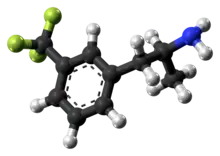 | |
 | |
| Names | |
|---|---|
| Preferred IUPAC name
1-[3-(Trifluoromethyl)phenyl]propan-2-amine | |
| Other names
3-Trifluoromethylamphetamine | |
| Identifiers | |
3D model (JSmol) |
|
| ChemSpider |
|
PubChem CID |
|
| UNII | |
CompTox Dashboard (EPA) |
|
| |
| |
| Properties | |
| C10H12F3N | |
| Molar mass | 203.208 g·mol−1 |
Except where otherwise noted, data are given for materials in their standard state (at 25 °C [77 °F], 100 kPa).
Infobox references | |
Norfenfluramine, or 3-trifluoromethylamphetamine, is a never-marketed drug of the amphetamine family that behaves as a serotonin and norepinephrine releasing agent and potent 5-HT2A, 5-HT2B, and 5-HT2C agonist. The action of norfenfluramine on 5-HT2B receptors on heart valves leads to a characteristic pattern of heart failure following proliferation of cardiac fibroblasts on the tricuspid valve, known as cardiac fibrosis.[1] This side effect led to the withdrawal of fenfluramine as an anorectic agent worldwide, and to the withdrawal of benfluorex in Europe,[2] as both fenfluramine and benfluorex form norfenfluramine as an active metabolite. It is a human TAAR1 agonist.[3]
See also
- Fenfluramine
- Benfluorex
- Norfenfluramine is the precursor to flucetorex
References
- ↑ Setola, V.; Dukat, M.; Glennon, R. A.; Roth, B. L. (2005). "Molecular Determinants for the Interaction of the Valvulopathic Anorexigen Norfenfluramine with the 5-HT2B Receptor" (PDF). Molecular Pharmacology. 68 (1): 20–33. doi:10.1124/mol.104.009266. PMID 15831837. S2CID 30906680.
- ↑ "European Medicines Agency recommends withdrawal of benfluorex from the market in European Union" (PDF). European Medicines Agency. 2009-12-18. Archived from the original (PDF) on 2009-12-22.
- ↑ Lewin AH, Miller GM, Gilmour B (December 2011). "Trace amine-associated receptor 1 is a stereoselective binding site for compounds in the amphetamine class". Bioorg. Med. Chem. 19 (23): 7044–8. doi:10.1016/j.bmc.2011.10.007. PMC 3236098. PMID 22037049.
| 5-HT1 |
| ||||||||||||||||||||||||||||||||||||||
|---|---|---|---|---|---|---|---|---|---|---|---|---|---|---|---|---|---|---|---|---|---|---|---|---|---|---|---|---|---|---|---|---|---|---|---|---|---|---|---|
| 5-HT2 |
| ||||||||||||||||||||||||||||||||||||||
| 5-HT3–7 |
| ||||||||||||||||||||||||||||||||||||||
| |||||||||||||||||||||||||||||||||||||||
| DRAsTooltip Dopamine releasing agents |
| ||||||||||||||
|---|---|---|---|---|---|---|---|---|---|---|---|---|---|---|---|
| NRAsTooltip Norepinephrine releasing agents |
| ||||||||||||||
| SRAsTooltip Serotonin releasing agents |
| ||||||||||||||
| Others |
| ||||||||||||||
See also: Receptor/signaling modulators • Monoamine reuptake inhibitors • Adrenergics • Dopaminergics • Serotonergics • Monoamine metabolism modulators • Monoamine neurotoxins | |||||||||||||||
| TAAR1 |
| ||||||||||
|---|---|---|---|---|---|---|---|---|---|---|---|
| TAAR2 |
| ||||||||||
| TAAR5 |
| ||||||||||
† References for all endogenous human TAAR1 ligands are provided at List of trace amines
‡ References for synthetic TAAR1 agonists can be found at TAAR1 or in the associated compound articles. For TAAR2 and TAAR5 agonists and inverse agonists, see TAAR for references.
| |||||||||||
| Phenethylamines |
|
|---|---|
| Amphetamines |
|
| Phentermines |
|
| Cathinones |
|
| Phenylisobutylamines | |
| Phenylalkylpyrrolidines | |
| Catecholamines (and close relatives) |
|
| Miscellaneous |
|
This article is issued from Wikipedia. The text is licensed under Creative Commons - Attribution - Sharealike. Additional terms may apply for the media files.